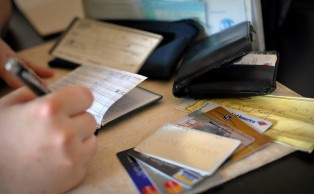7 Ways to Work Around Bank of America’s No-Cash Deposits Policy
It’s no secret that online banking and innovative technology are changing the way people bank.
But, there are some transactions that can’t be replaced by even the most advanced software.
That’s why Bank of America customers are not too happy about the recent policy change, banning third-party individuals from making cash deposits into someone else’s account.
Long gone are the days where grandma could walk into her local bank to deposit $25 into your account as a birthday surprise.
Here we explain the reasons why Bank of America made this change, and explore alternatives to making cash deposits into someone else’s account.
Bank of America’s No-Cash-Deposits Policy
Following on the heels of other national banks, Bank of America no longer accepts cash deposits into an account that’s not yours.
So, why did they make this change?
According to the company, this policy change is for the safety and security of its customer’s accounts.
In addition, it is meant to prevent criminal activity, including money laundering.
Under the law, banks are required to take certain steps to prevent and combat money laundering.
Although banning your grandmother from depositing cash into your account might seem extreme, by making this change across all personal accounts, Bank of America is taking one more step to ensuring they have the best policies in place to prevent illegal activity.
Luckily, there are multiple ways to get around this new policy if you need to send or receive money.
1. Joint Accountholder
Two or more people can “own” an account. This means that they have full access to all the account details, including the ability to deposit or withdrawal money in the account.
The only difference between a joint account and individual account is the number of people who own the account.
If you already have an account with Bank of America, you can add a person to the account, making it a joint account.
If you don’t have an account already opened, opening a joint account is the same process as an individual account. Both individuals will need to provide information and identification in order to open the joint account.
A joint account is a good option for someone who regularly receives cash deposits from a specific person, a trusted source.
For example, if a college student is studying abroad, opening a joint bank account with a parent might be an ideal option in case they need money deposited into their account from time to time.
2. Personal Check
You might be surprised to learn that many people still write checks. And, it’s not just the retiree holding up the under-10-items-or-less line at the grocery store.
Writing checks is one of the cheapest ways to exchange money. Aside from the cost of checks, writing, depositing or cashing a check is free. Some checking accounts even give you your first set of checks for free.
The downside of writing a check is that the money won’t always be immediately available. It can take usually anywhere from 2 to 5 days for the check to clear, depending on the amount of the check and how much money you have in your account.
It can take up to 10 days for a large check over $1,500 to clear, making a wire transfer a better option if you need access to a large sum of money as soon as possible.
Because almost all banks and credit unions offer mobile deposit, you won’t need to visit a bank to cash a check anymore. You can simply deposit the check by taking a picture of the check and following the instructions on the app.
So, don’t throw away your checkbook just yet. Giving or paying someone a check is still a secure and convenient way to transfer money.
3. Get a Money Order
You’ve seen the yellow and black Western Union signs advertising money order services, but did you know it’s just as easy to send a money order through the post office, grocery store and Wal-Mart, to name a few?
Money orders work by prepaying a specific amount of money, in turn for a piece of paper that is similar to a check. The money order will include name of the person who is going to cash or deposit the money order, and the bank or business that issued the money order.
Since you’re handing over cash in order to receive this piece of paper, money orders are considered a guaranteed form of payment.
The fees are minimal compared to other alternatives. Individuals who do not have a bank account often rely on money orders to send or receive payments, such as rent or utilities.
If you do receive a money order, you will have immediate access to the cash, similar to a cash deposit in a bank account.
Compare Money Order Fees at Banks & Retailers
| Company | Fees | Limits |
|---|---|---|
| Chase | $5 | $1,000 |
| Bank of America | $5 | $1,000 Not available in Arizona, California, Nevada. |
| Wells Fargo | $5 | |
| Citibank | $5 | |
| U.S. Bank | $5 | |
| Truist | $5 for customers $10 for non-customers | |
| PNC Bank | $5 | |
| BMO Harris Bank | $5 | $1000 |
| TD Bank | $5 | |
| Capital One | Does not issue money orders | |
| Regions Bank | $1 | $1000 |
| Santander | $5 | |
| BMO Harris Bank | $5 | $1000 |
| M&T Bank | $6 | |
| CVS | $0.70 | $500 |
| USPS | $1.20 | $500 |
| Walmart | $0.70 | $1,000 |
4. Zelle
Person-to-person payments are relative newcomers to the banking industry, compared to other electronic forms of payment transfers.
You can send, receive or request money to almost anyone with an email address or mobile phone number, and eligible bank account in the U.S.
Backed by more than 30 banks, Zelle is giving its biggest competitors, Venmo, Popmoney, and PayPal, a run for their money. But, unlike many of its competitors, Zelle is free.
Since Zelle is set up through your bank, you can quickly and securely send money, without entering your bank account information. The only information you need to enter is an email address or mobile phone number, and the amount of money you want to send.
Within minutes, the recipient will receive a notification that a payment or deposit has been sent.
Zelle Pay Limits at Top U.S. Banks
| Bank | Daily limits | Monthly limits |
|---|---|---|
| Ally | Up to $500/day | Up to $10,000/30 days |
| Bank of America | ||
| Capital One | Up to $2,500/day | Up to $10,000/month |
| Charles Schwab | Up to $2,500/day | Up to $5500/30 days |
| Chase | – | |
| Citibank | If you have been a Citi customer for less than 90 days: up to $1,000/day If you have been a Citi customer for more than 90 days: | If you have been a Citi customer for less than 90 days: If you have been a Citi customer for more than 90 days: up to $10,000/month up to $15,000/month |
| Citizen’s Bank | Up to $1,000/day | Up to $5,000/month |
| Discover | $600 per day | – |
| KeyBank | Up to $2,000/day ($500/day to start) | – |
| PNC Bank | Up to $1,000/day | Up to $5,000/month |
| TD Bank | ||
| Truist | Up to $2,000/day | Up to $10,000/rolling 30-day period |
| U.S. Bank | Between $1,500 and $2,500/day | Between $5,000 and $10,000/month |
| Wells Fargo | Up to $3,500/day | Up to $20,000/month |
5. Prepaid Card
A prepaid card looks and feels like a standard debit or credit card, except it’s not linked to a bank account.
Major credit card companies like Visa, MasterCard, and American Express offer prepaid cards that you can use anywhere that type of card is accepted.
To get started, you can order a card online or find a retailer close to you that offer prepaid cards.
You’ll be able to deposit cash onto the card at select ATMs, bank branches or retailers. You can even download the app and deposit checks, or arrange for direct deposit from your employer.
A prepaid card comes in handy since you can request a second card to give to a friend or family member. That person can load cash onto the card that you will be able to use immediately.
In addition, anyone can put money onto a prepaid card and give it to you to use however you want.
Monthly Fees range anywhere from $5 to $10 a month, making prepaid cards an affordable option.
A prepaid credit or debit card is ideal for someone who receives regular money deposits into their account, such as a teen or young adult.
6. Wire Transfer
A wire transfer is not necessarily the cheapest option, but it’s still an option. A wire transfer is a service to send or receive electronic payment by wire.
You can send or receive money to your own accounts at other financial institutions, send or receive money to someone else, or to a business.
To receive a wire transfer, you’ll need to provide the following information to the payee:
- Name and address
- Bank name and address
- Wire transfer routing number
- Account Number
Specific wire transfer instructions can be found on Bank of America’s website once you sign in to your account, under the “Information & Services” tab.
Wire transfer fees are dependent upon the amount of money that is sent. You should expect to pay anywhere from $25 to $40.
A wire transfer is a speedy way to send or receive money, both domestically and internationally. For example, if you’re selling your car to a friend, they can wire the money to your account, rather than pay you with a wad of cash.
7. Switch Banks
If you just can’t work around the no-cash deposit policy, it might be time to shop around for a new bank.
Some of the larger banks have this rule — Chase and Wells Fargo. Check with another bank to see if they have a different policy before you decide to close your account.
During your search for a new bank, don’t discredit online banks. Higher interest rates and lower fees might be just what you need to get over the fact that you can’t receive cash deposits from someone else.
Conclusion
Banks will continue to make changes to policies and procedures as technology and criminal activity evolve.
Just because you can’t deposit cash into someone else’s account doesn’t mean there aren’t better and more efficient ways to give them money.
With these changes comes even better solutions, that one day we will ask ourselves, “how did we ever live without it?”


